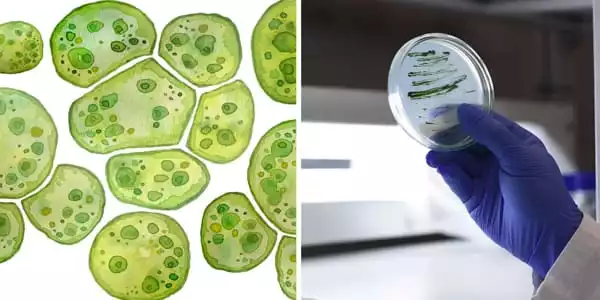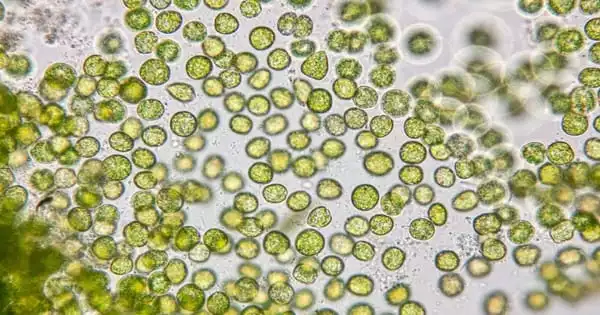The humble algae that cover the surface of ponds and seas may hold the key to increasing the efficiency of artificial photosynthesis, allowing scientists to produce more energy while producing less waste.
According to one study, encasing algae protein in liquid droplets can increase the algae’s light-harvesting and energy-conversion properties by up to threefold. This energy is produced by the algae during photosynthesis, which is the process by which plants, algae, and certain bacteria harness energy from sunlight and convert it to chemical energy. When light strikes a droplet, light waves travel around the droplet’s curved edges. Light is effectively trapped within the droplet for a longer period of time, allowing for more photosynthesis to occur and thus generating more energy.
Nanyang Technological University, Singapore (NTU Singapore) researchers discovered that encasing algae protein in liquid droplets can increase the algae’s light-harvesting and energy-conversion properties by up to threefold. This energy is produced by the algae during photosynthesis, which is the process by which plants, algae, and certain bacteria harness energy from sunlight and convert it to chemical energy.
Artificial photosynthesis, which mimics how plants convert sunlight into energy, may be a sustainable way of generating electricity that does not rely on non-renewable fossil fuels or natural gas. Because the natural energy conversion rate from sunlight to electricity is low, increasing the total amount of electricity produced may make artificial photosynthesis commercially viable.
Phycobiliproteins have promising applications in biotechnology and solid-state devices due to their unique light-emitting and photosynthetic properties. Increasing the energy harvested by the light-harvesting apparatus has been at the forefront of research and development efforts for organic devices that use light as a power source.
Chen Yu-Cheng
The research, led by Assistant Professor Chen Yu-Cheng of the School of Electrical and Electronic Engineering, focused on a type of protein found in red algae. These proteins, known as phycobiliproteins, are in charge of absorbing light within algae cells in order to kickstart photosynthesis. Phycobiliproteins absorb light energy from a wide range of wavelengths, including those that chlorophylls do not absorb well, and convert it to electricity.
Assistant Professor Chen stated: “Phycobiliproteins have promising applications in biotechnology and solid-state devices due to their unique light-emitting and photosynthetic properties. Increasing the energy harvested by the light-harvesting apparatus has been at the forefront of research and development efforts for organic devices that use light as a power source.”
The team’s research could lead to a new, sustainable method of generating electricity from sunlight that does not rely on non-renewable fossil fuels or natural gas. A new bio-inspired technology based on phycobiliproteins may be used to create more efficient solar cells, paving the way for greater efficiency in artificial photosynthesis.
Using algae as a source of biological energy is a hot topic in sustainability and renewable energy, as it has the potential to reduce the amount of toxic by-products produced during the manufacturing of solar panels. The study supports NTU’s commitment to sustainability as part of its 2025 strategic plan, which seeks to understand, articulate, and address humanity’s environmental impact. The findings were published in the scientific journal ACS Applied Materials Interfaces, and the cover was chosen.

Tripling artificial photosynthesis efficiency
Sunlight is absorbed by microalgae and converted into energy. To increase the amount of energy that algae can generate, the researchers devised a method that encased red algae in small liquid crystal micro-droplets 20 to 40 microns in size and exposed them to light.
When light strikes a droplet, an effect known as “whispering-gallery mode” occurs, in which light waves travel around the droplet’s curved edges. Light is effectively trapped within the droplet for a longer period of time, allowing for more photosynthesis to occur and thus generating more energy. The energy produced during photosynthesis in the form of free electrons can then be captured as an electrical current by electrodes.
“The droplet behaves like a resonator, confining a lot of light,” Asst Prof Chen explained. “This increases the rate of photosynthesis by exposing the algae to more light. A similar result can be obtained by coating the droplet’s outside with algae protein as well.”
“By using micro-droplets as a carrier for light-harvesting biomaterials, we were able to generate significantly more electricity due to the strong local electric field enhancement and photon confinement inside the droplet,” he said.
The droplets can be easily manufactured in large quantities at a low cost, making the research team’s method widely applicable. According to Asst Prof Chen, the majority of algae-based solar cells produce 20-30 microwatts per square centimetre (µW/cm2). When compared to the energy generation rate of the algae protein alone, the NTU algae-droplet combination increased this level of energy generation by at least two to three times.
Converting “bio-trash” to bio-energy
The goal of synthetic photosynthesis is to mimic the natural biological process by which plants convert sunlight into chemical energy. The goal is to find a way to make energy renewable, reliable, and storable without negatively impacting the environment. One of the difficulties with artificial photosynthesis is producing energy as efficiently as other solar-powered energy sources, such as solar panels. Solar panels have an average efficiency rating of 15 to 20%, whereas artificial photosynthesis is currently estimated to be 4.5 percent efficient.
Assistant Professor Chen stated: “In terms of generating electricity, artificial photosynthesis is not as efficient as solar cells. It is, however, more renewable and sustainable. Because of the growing interest in environmentally friendly and renewable technologies, extracting energy from light-harvesting proteins in algae has piqued the interest of researchers in the field of bio-energy.”
Asst Prof Chen envisions one possible application of “algae farms,” in which densely growing algae in bodies of water are eventually combined with larger liquid crystal droplets to create floating power generators.
“The micro-droplets used in our experiments have the potential to be scaled up to larger droplets, which can then be applied to algae outside of a laboratory environment to generate energy. While some people find algae growth to be unsightly, they play an important role in the environment. Our findings demonstrate that it is possible to convert what some may regard as “bio-trash” into “bio-power.” “Asst Prof Chen stated.





